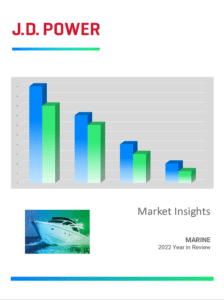• Lenny Sims, VP Business Development/Strategy – Specialty Vehicles for J.D. Power and the MRAA Discuss Insights on the Current Marine Market

By Drew Mick, MRAA Data Specialist
Drew Mick: The overview suggests that boat values started 2022 high but then flipped in the latter part of the year. This is in stark contrast to what was happening in 2021, when we were talking about signs that the market had gone crazy. Can you dig into what was happening last year, compared to 2021, that drove this change?
Lenny Sims: When you look at 2021, things were still on that skyrocketing trend that started in 2020, which all came because of Covid. Boating was seen as an escape. Price went out of control. At the end of the day it’s all supply and demand, and boats were no exception. What we were starting to see with 2022 is a return to the norm. For instance, seasonality was hardly a thing in 2020 and 2021, yet here in 2022 it is beginning to show again. When everything seems down in 2022, it’s really just a flow or trend back to where things were before. And if you take that all into account, things are still slightly on the incline, especially when you compare it to 2019, our last “normal” year.
Also, what are the possible repercussions of this change for the dealer in 2023? What about for the dealer and their sales team? How can dealers use this information to help them outperform the market in 2023?
In terms of repercussions for dealers, I hesitate to even call it a repercussion, but what this means for dealers in 2023, they need to be more conscientious and pragmatic with trade-in allowances and the amount of trade-in value they are going to give to consumer who are looking to buy new product.
Looking at the Marine Values vs. Traffic data, there seems to be little difference across the year in terms of Average Retail Value, with the exception of a slow decrease throughout the last quarter of the year. What insight can dealers take away from this data? How can and should they use it to make better decisions?
This could parallel what I said before for the first question. Seeing a decline in traffic for that final part of the year is typical in your average year. As I mentioned before, 2022 is seeing the return of seasonality in the normal yearly cycle. So when you look at this data, and see that slight decline, it is nothing to be concerned about at all.
In comparing the 2022 year-end report to the 2021 year-end report, it appears you broke the boat categories out differently. What was your reasoning for breaking down the categories the way you did? Is there a trend you’re trying to identify or isolate?
This was simply due to wanting to change how we reported this data, and admittedly this is subject to change again. While we kept our marine categories limited in our last year-end report, we saw that this year, we had the ability to do more with it, so we wanted to try it out.
The Model Years data sheds light on consumer interest that perhaps can help dealers make decisions on what pre-owned inventory to acquire. Generally, there seems to be a steady decline the further we go back, but I am wondering if the slight 2008 “bump” is noteworthy?
The answer to this may be fascinating to some, but boring to others. Typically, the operating window for our data is 15 years. When people come in with a boat to trade in or sell, the dealers look in their system for the best comparisons. Obviously, the best way to do this is comparing year to year, but if the boat year falls before this 15-year window, dealers will simply go to the next best thing: comparing to the lowest year available. This would potentially lead to that slight uptick.
Please tell us about the story the Fuel Price Data graphs might tell a dealer. For example, is this evidence that high fuel prices are impacting web traffic more now and in 2022 than in 2021 and 2020? And/or could some of this downward movement simply be the usual seasonality?
The better story with looking at this data is how each boat type compares to each other. For example, when looking at the chart for outboard boats and stern drive boats, this would tell me that outboards are more affected by fuel prices than stern drive. There is much more movement happening with them. The same can be said with the inboard boats and personal watercraft chart, with more volatility happening with the former. Another important thing to keep in mind with this is that the movement in the traffic tends to be about a month behind any changes in fuel pricing.
Can you shed some light on any other big takeaways or key indicators in this report that are meaningful to you and provide valuable insight to marine dealers and their staff
My final thought that I really can’t emphasize enough is that dealers need to realize that we are on a return to the norm. The days of swinging for the fences and hitting home runs are over. The trend is leveling back to the standard, so dealers will need to return to those practices that were working for them before these past two crazy years. To continue the baseball metaphor, singles and doubles are just fine in winning a game.

MORE DATA: For more information about trends in boat values, download the J.D. Power Market Insights 2022 Report. This is the first in a series of quarterly reports we will be publishing in the MRAA Resource Center. For an overview of J.D. Power and its boat valuation process, see the MRAA’s previous Q&A session with Sims on the 2021 Marine Market Insights Report.




